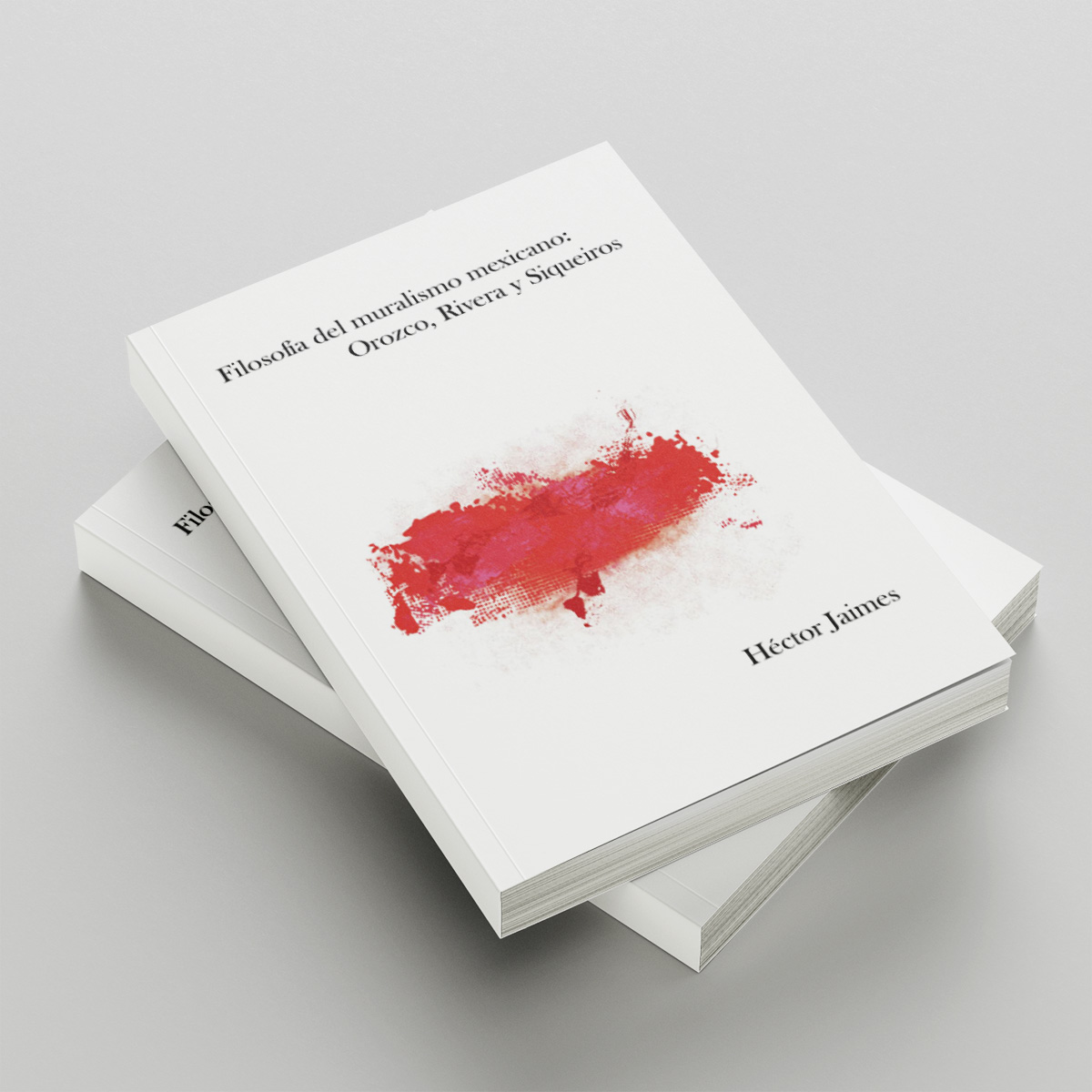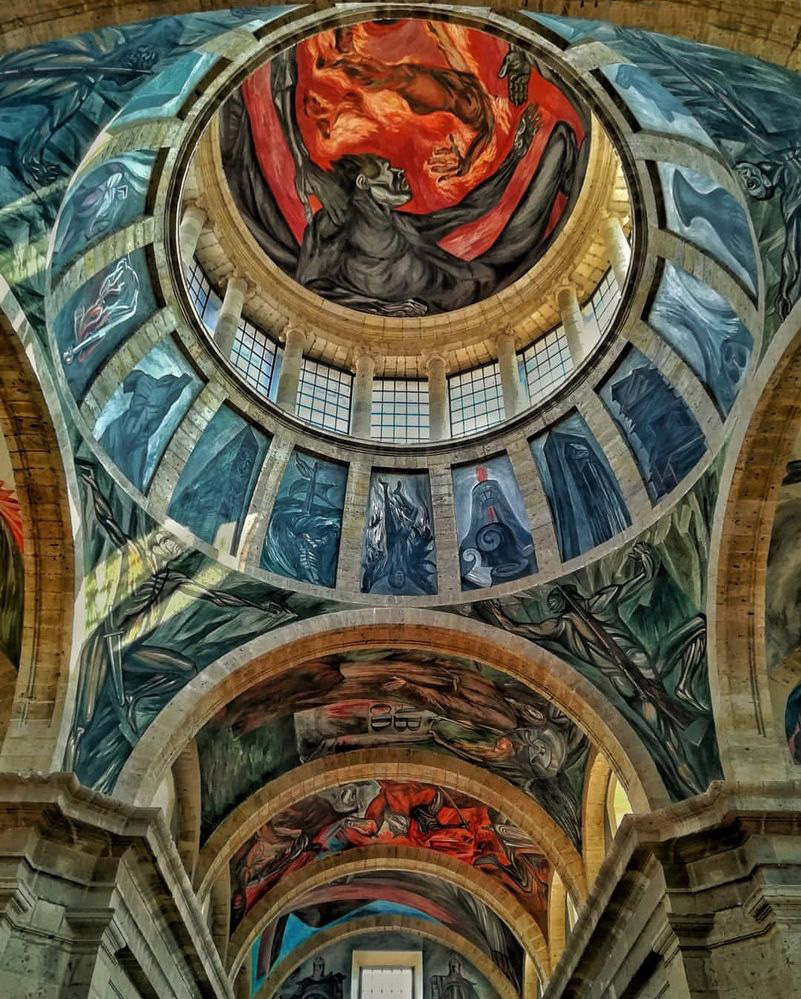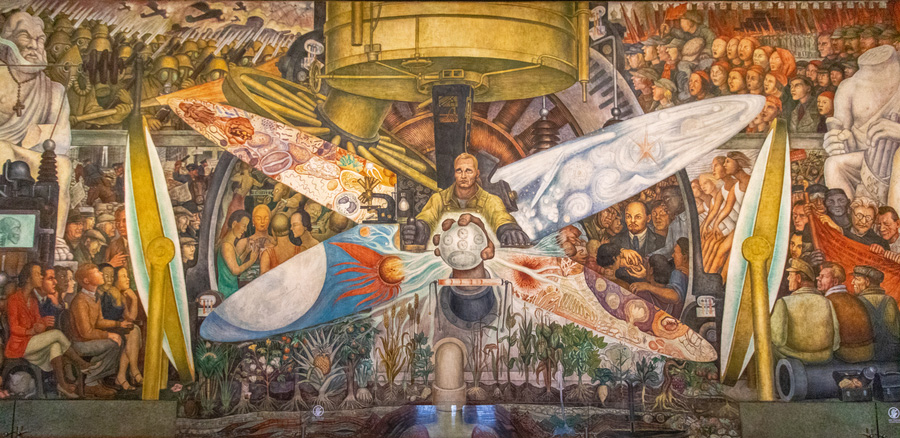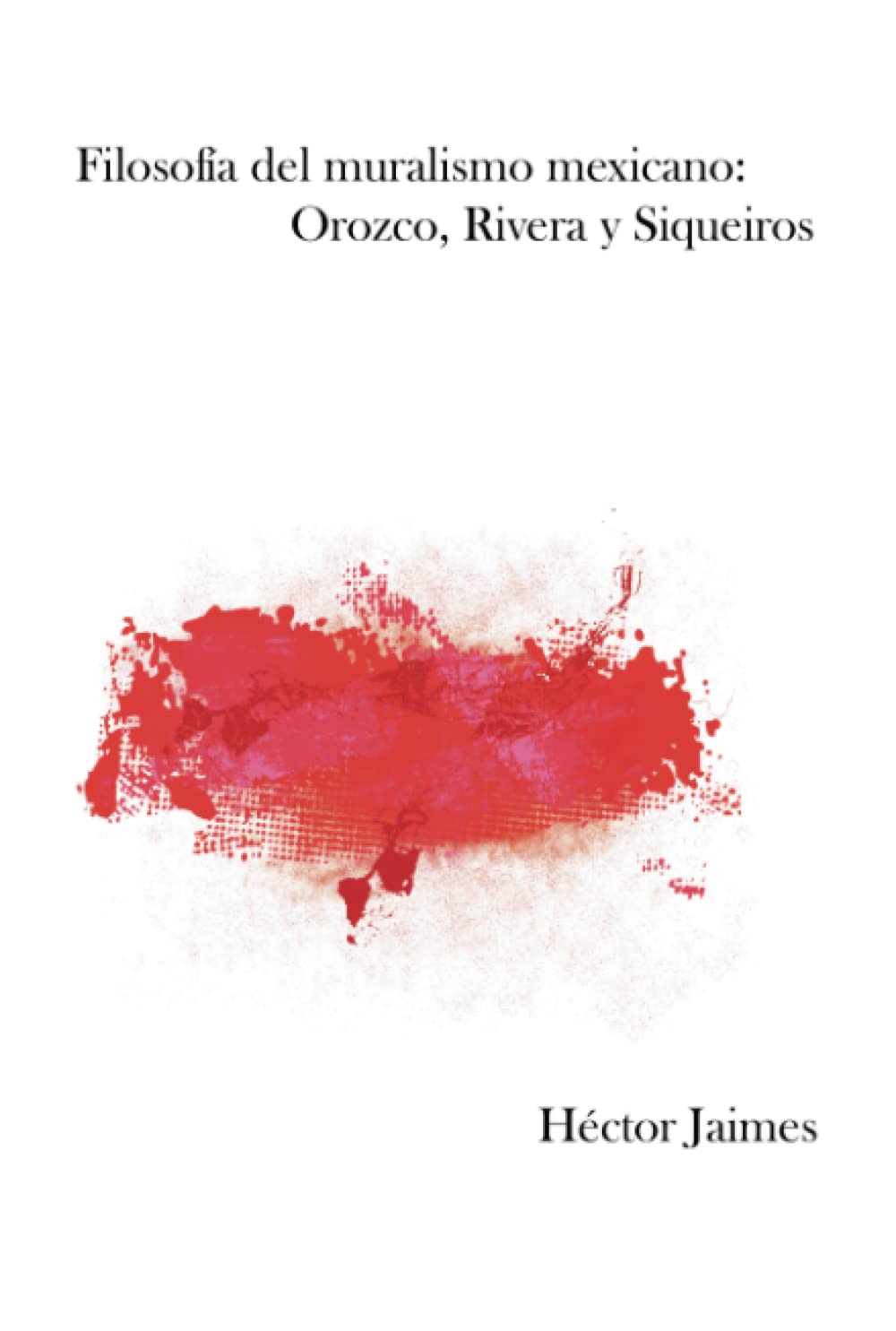
The philosophy of Mexican muralism
THE PHILOSOPHY OF MURALISM
Essay on the book: The philosophy of Mexican muralism.
Essay on the book: The philosophy of Mexican muralism.
- The philosophy of Mexican muralism transcended the limits of nationalism and inaugurated a new conception of public art that questioned the established order through revolutionary aesthetic proposals.
Introduction
Walking the streets of my hometown, I never ceased to be amazed by the colorful large-scale outdoor works. From an early age and thanks to my grandfather, murals awakened in me an overwhelming curiosity. Over time and thanks to school, I came to understand that muralism was an artistic movement that went far beyond aesthetics: it embodied an innovative vision of the role of art in society.
I remember finding echoes of muralism in the paintings of my classmates in the Faculty of Arts. I learned much more as I got deeper into my career and where I had the joy of learning even more was in “La Tallera” where I did my social service before graduating as a Bachelor of Arts. It was there where I found this book: Philosophy of Muralism. This is an essay in which I reflect what I found most interesting in this fascinating book.
This book tells us that despite the criticisms it faced in its time, muralism managed to consolidate itself as one of the most transcendental artistic movements in Mexican art. Its works, many of which are now considered world heritage, marked a triumph in the representation of our multicultural reality. It is important to recognize that its transcendence lies in having renewed the social role of art and inviting us to a constant reflection on our identity.
To understand the depth of this movement, the book analyzes both its historical context and the individual contributions of artists such as Orozco, Rivera and Siqueiros. In their works, these pioneers embodied a revolutionary aesthetic vision that challenged schemes to incorporate the majority in the construction of our collective memory. Their legacy continues to summon us to imagine new futures that make the dream of an inclusive homeland a reality.
THE ORIGIN AND DEVELOPMENT OF MEXICAN MURALISM
After the end of the war phase of the Mexican Revolution in the 1920s, the country began a process of reconstruction. It was then that an artistic movement emerged that would mark Mexico’s cultural identity: muralism. We Mexicans felt indebted to our indigenous and peasant origins, which had been trampled upon during years of oppression. Artists such as Diego Rivera, José Clemente Orozco and David Alfaro Siqueiros decided to recover these roots through large fresco murals with vibrant colors that would bring art to all citizens.
The beginnings of muralism were influenced by various currents. On the one hand, the nationalism promoted by the Revolution sought to consolidate a homogeneous Mexican culture. But Marxist ideas also influenced some painters, who decided to represent the workers’ and peasants’ struggles. Thus, while Orozco showed in his murals the suffering of the people with anguished faces, Rivera would soon become the maximum representative of social realism. Unfortunately, his political stances would earn him expulsion from the Communist Party in 1929.
However, upon his return from Europe in 1920, Rivera had undergone a transformation. In Mexico he discovered his true vocation: to capture with vigorous colors the popular idiosyncrasy of our land. It was then that he painted key works such as The Creation for the ENP or the murals of the SEP, in which he glorified the peasant. Thanks to his technical skill and narrative capacity, he was able to capture the attention of politicians and the public, as when he portrayed the history of the country in the National Palace.
Unfortunately, it was not all success. Political divergences led to clashes between the muralists themselves. Siqueiros criticized Rivera’s decorative style, while the latter distanced himself from Rivera’s sectarianism. Thus, Mexican muralism transcended the limits of political tendencies, establishing itself as an autochthonous artistic movement.
Gradually, muralism was transforming the traditional notion of art. By taking it to massive public spaces such as schools or the CDMX subway, it brought culture closer to the people. In fact, today many of these murals are still part of our collective identity.
THE CHARACTERISTICS AND LEGACY OF MEXICAN MURALISM
The greatness of muralism lies in having vividly captured the essence of Mexico. As a student, when I walked through the streets of the Historic Center, I was surprised by the crudeness of the indigenous faces in Orozco’s Cathedral. Later I understood that this art sought to dignify the forgotten of history. The muralists knew how to portray the diversity of our idiosyncrasy through workers, peasants and pre-Hispanic figures. By critically representing the past, they provide us with the keys to understand the present.
His legacy transcended the artistic to become cultural heritage. When I visited the Palace of Fine Arts as a child, I was impressed by Siqueiros’ epic painting of the Aztecs on the warpath. Since then I understood that we were before an art capable of recording the memory of a people. The murals were erected as witnesses of our identity, which is why their preservation is fundamental. Thanks to them, many generations have been able to learn about our roots.
The influence of muralism spread throughout Latin America. On a trip to Buenos Aires, I was able to appreciate the similarities with Argentine street art, which took up the legacy of participating in public spaces. This movement inaugurated a rupturist aesthetic capable of questioning the limited framework of the museum. By bringing art to the people, it democratized access to culture in ways previously unthinkable.
However, their transcendence lay in more than their aesthetic impact. Upon returning from that trip, I realized that these murals also knew how to embody the social struggle of our peoples. By depicting inequalities, they remain a powerful call for political reflection. Beyond time, their legacy reinforces the need to build a more inclusive and egalitarian society.
THE MEANING AND IMPACT OF MEXICAN MURALISM
Muralism knew beyond capturing a groundbreaking aesthetic. As I walked through the SEP and appreciated Rivera’s vigorous brushstrokes, I was surprised by his epic historical vision. Years later, I understood that those murals sought to go beyond a passive narrative: they sought to analyze the roots of our collective identity in order to generate awareness. By questioning the past through a critical lens, they allowed us to glimpse the contradictions of our society and the struggles to resolve them.
This movement renewed the ways of seeing and interpreting reality. Their works transcended the passive role of the painted to assume a complex, dynamic and provocative meaning. The murals raise questions about our historical and social context, at the same time that they provide the tools to think of solutions. His dialogue with the audience broke new ground to establish a living work, in constant construction.
Beyond borders, its importance permeated several latitudes. Due to the similarities with local expressions in Chile witnessed during a trip, I was able to confirm that this style renewed plastic languages in Latin America. By transcending the classrooms and squares to found new schools, its mass appeal brought about the encounter of the arts with the popular majorities.
Its call remains unchanged after more than a century. The murals continue to be spaces open to debate, where past and present merge in a dynamic dialogue. They remind us that reflection on our origins and present challenges must be constant and inclusive, in order to forge a more equitable future for all people.
OROZCO
José Clemente Orozco was one of the main promoters of Mexican muralism. Despite his early academic training in cities such as Barcelona and Madrid, Orozco knew how to adapt his technique to Mexico’s post-revolutionary context. His first murals at the Escuela Nacional Preparatoria, such as Maternidad (Maternity), marked the course of this new pictorial genre that sought to represent the diversity of Mexican society. With a unique sensibility, Orozco vividly portrayed the social tensions of his time through the bold figures that continue to challenge us from the walls he decorated.

RIVERA
Diego Rivera was one of the founders of Mexican muralism along with Siqueiros and Orozco. His years living and studying in Europe, especially the fourteen he spent in Paris, had a great influence on his initial artistic development. However, upon his return to Mexico, Rivera was able to masterfully capture the reality of his country through imposing works such as the murals of the Secretariat of Public Education and the historic mural in the National Palace. With his monumental and realistic style, Rivera left important reflections on Mexican identity and the difficult history of his people that continue to inspire new generations.

SIQUEIROS (MY FAVORITE PAINTER)
David Alfaro Siqueiros was one of the founders of Mexican muralism and stood out for his political commitment to Marxist ideas. His first murals at the Escuela Nacional Preparatoria such as Los elementos and Los mitos caídos already showed his inclination to represent the social reality of Mexico. Siqueiros promoted the use of new experimental techniques that took muralism to another level as can be seen in his emblematic mural Del porfirismo a la revolución. Throughout his life he developed a vast body of work in which he explored diverse media with the ultimate goal of creating art at the service of the revolutionary transformation of society.

CONCLUSION
The muralists knew how to transform the walls into blackboards where collective history is captured in an intense and lively way. When I see the works of Orozco, Rivera and Siqueiros that continue to amaze me every time I visit the Palace of Fine Arts, I realize that through these murals we not only admire artistic beauty, but also reflect on our origins.
The philosophy of muralism transcended mere decoration, because with its aesthetic dynamics it encouraged public debate on transcendental issues. By accepting the constant reinterpretation of its works in the light of new contexts, they always remain current. Muralism understood that art should not be enclosed in the past or in fixed concepts, but be a channel to the future. His murals continue to invite us to continue building a homeland where all people fit in community.
It must be understood that despite the many criticisms received during its time, this movement was able to capture the cultural diversity of our nation in an inclusive way. The murals show the faces of indigenous people and peasants as protagonists of our identity, which marked a triumph in artistic representation. Their works show an unprecedented cultural democratization, taking art out of the elites and into public spaces.
The muralists understood that only by recognizing our past in all its complexity could we forge a more just future. And that is why their work continues to transcend the buildings they inhabit, to engage all of us in a permanent dialogue about our common destiny. The preservation of this rich heritage legacy is key to understanding the roots of what we, as a society, are still building.





0 comments